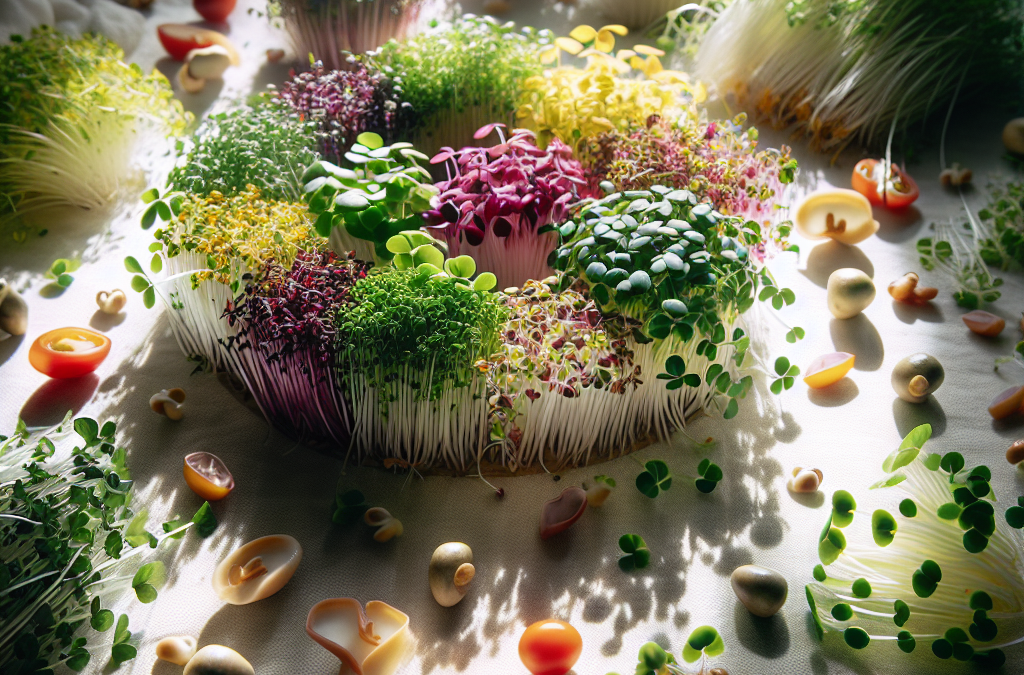What are Microgreens and Sprouts?
Defining Microgreens
So, let’s kick things off with the basics. Microgreens are essentially young plants that are harvested just after they develop their first true leaves. You might have seen them in fancy salads or as a garnish on gourmet dishes. And trust me, these tiny plants pack a serious flavor punch! We’re talking about everything from arugula to radishes. Each type brings its own unique taste and nutritional profile to the table.
Growing microgreens is also a blast! You don’t need a green thumb to get started—you can grow them on your kitchen counter. They need minimal space, soil, and sunlight, which makes them perfect for urban living or anyone short on gardening space. Honestly, it feels so rewarding to see those little greens sprout up!
When it comes to nutrition, microgreens are like little superstars. Studies have shown that some varieties contain up to 40 times more nutrients than their mature counterparts. Think vitamins, minerals, and antioxidants! Adding a sprinkle of microgreens to your meals is an easy way to boost their nutritional value.
Understanding Sprouts
Now, let’s chat about sprouts. Unlike microgreens, sprouts are germinated seeds that haven’t developed leaves yet. They’re often germinated in water and can be eaten raw. Common sprout varieties include alfalfa, mung beans, and broccoli sprouts—each with a unique flavor and health benefits.
Sprouts are typically known for their crunch. When you bite into them, you get that satisfying crunch, which adds texture to salads, sandwiches, and wraps. My personal favorite is adding alfalfa sprouts to a classic veggie sandwich—it takes it to the next level!
And let me tell you, sprouts are super easy to make. All you need is some seeds, water, and a jar, and you’re set for a nutritious snack. It takes only a few days for them to grow, and you’ll be amazed at how much you can produce in a short amount of time.
Health Benefits of Microgreens and Sprouts
One thing I love about adding microgreens and sprouts to my diet is the health benefits that come along for the ride. Let’s break it down a bit. First off, these greens are dense in nutrients. We’re talking about vitamins A, C, E, and K, as well as a host of minerals like calcium and iron. You can really feel the difference in your energy levels when you start incorporating more of these into your meals.
Another benefit is their high antioxidant content. Antioxidants are essential for fighting off free radicals in the body, which can cause aging and chronic diseases. This means that by munching on microgreens and sprouts, you’re not just enhancing the flavor of your meals but also giving your body a fighting chance against illnesses.
Lastly, they’re a great way to enhance digestion. Microgreens and sprouts contain enzymes that can aid your digestive system. Incorporating these into your meals can lead to better gut health, which is something we all strive for. I found that my tummy feels happier and less bloated after making these little greens a regular part of my diet.
How to Incorporate Microgreens and Sprouts into Your Meals
Adding Them to Salads
One of the simplest ways to enjoy microgreens and sprouts is by tossing them into your salads. Instead of just the usual lettuce, consider a mix of different greens for a flavor explosion. Microgreens add a peppery kick, while sprouts give that crunch I mentioned earlier. It’s a match made in salad heaven!
When I’m making a salad, I love to get creative and mix various textures and flavors. Pairing spicy microgreens like mustard greens with the mildness of sprouts can create a symphony of flavors. Add in some cherry tomatoes, colorful bell peppers, and a zesty vinaigrette, and you’ve got yourself a bowl of joy!
Trust me; once you get into the habit of adding these greens to your salads, you won’t turn back. Not only are they nutritious, but they also keep your meals exciting! Stay away from the boring old salad rut!
Smoothies and Juices
If you’re more of a smoothie person, don’t worry! Microgreens and sprouts can easily be blended into your daily smoothies. Imagine a vibrant green smoothie packed with fruits, veggies, and a handful of nutrient-rich microgreens. You won’t even taste them, but your body will be soaking up all those good vitamins.
One of my favorite recipes includes a banana, a handful of spinach, a splash of almond milk, and a handful of sunflower microgreens. Blend it all up, and you’ve got a refreshing drink that not only tastes great but also sets you up for a day of energy.
Juicing is another fantastic way to incorporate these greens. Throw a handful of broccoli sprouts into your juice for a nutrient boost. You’ll be amazed at how this little addition can change the game for your beverages!
Using Them as Garnishes
Never underestimate the power of a good garnish! Microgreens and sprouts can elevate a simple dish into something that looks like it belongs in a fancy restaurant. Whether it’s on top of soups, entrees, or even to jazz up a simple avocado toast, these tiny greens add that wow factor.
I often sprinkle microgreens over oven-roasted vegetables or my favorite grain bowls. It just takes those dishes up a notch! You’ll be surprised how something so small can make your meal way more Instagram-worthy—seriously, don’t skimp on the presentation!
Plus, they add an extra layer of flavor to your food, which is always a win in my book. So don’t skip this step next time you’re plating up a meal—be the gourmet chef that you truly are!
Get an Amazing Discount on the Best Certified Organic Whole Food Supplement!
Growing Your Own Microgreens and Sprouts
Easy Steps to Start Growing
If you’re feeling inspired after learning about the benefits of microgreens and sprouts, why not try growing your own? It’s super easy! First, gather your seeds (there are plenty of starter kits available) and a planting tray. You can use potting soil or a growing medium depending on what you prefer.
Next, follow the instructions on your seed packets regarding how deep to plant them and how much light they need. Most microgreens do well in bright, indirect sunlight. Water them carefully, keeping the soil moist but not waterlogged. In just a few days, you’ll see those little beauties start to sprout!
It’s a fun, educational activity, especially if you have kids. They’ll love watching the whole process and learning about where their food comes from—it’s a win-win for everyone!
Maintenance Tips
After planting, keeping an eye on your microgreens and sprouts is essential. Make sure to regularly check the moisture level of the soil. Overwatering can lead to mold, which is a bummer for your little plants. I like to mist them gently with water to keep things humid without soaking them.
It’s also crucial to keep them warm enough, especially in cooler months. If you notice your greens are stretched out or leggy, they might not be getting enough light. A little repositioning under a grow light can work wonders!
Lastly, be patient! Harvesting usually occurs within one to three weeks—it’s all worth it when you finally get to enjoy the fruits of your labor in delicious meals.
Harvesting and Using Your Homegrown Greens
Once your microgreens or sprouts have reached a suitable height, it’s time to harvest! Use scissors to cut them just above the soil line. Compost the leftover roots, and you’re left with a bounty of greens ready to jazz up your meals.
One of the best things about homegrown microgreens is that they taste fresher than anything you can buy from the store. I love tossing them onto my breakfast eggs or incorporating them into a post-workout smoothie.
Experiment with different varieties! Try different seeds each time you grow, and you might discover a new favorite. The beauty of growing your own is that you can customize your harvest based on what you enjoy eating. It’s your personal garden of deliciousness!
Wrap Up: The Journey of Microgreens and Sprouts
Our Nutritional Allies
Incorporating microgreens and sprouts into your diet has been such a fulfilling journey for me, and I can’t emphasize enough how they’ve transformed my meals. They’re not just companions to my lunch but also fantastic contributors to my overall wellness. With their rich nutrient profiles and health bonuses, these tiny greens bring a load of benefits that go beyond the dining table.
While they may be small in size, their impact on our health and nutrition is massive. Adding them to your meals offers a simple yet tasty way to boost your intake of vital nutrients. Plus, the excitement of growing them at home has made me appreciate my food even more.
I hope you feel inspired to give microgreens and sprouts a try yourself. Whether you decide to grow your own or simply incorporate them into your existing meals, you’ll be doing your body a favor. Cheers to tasty and nutritious eating!
FAQ
1. What are the health benefits of microgreens?
Microgreens are packed with vitamins, minerals, and antioxidants. Many studies suggest that they can contain up to 40 times more nutrients than their mature counterparts, contributing to better health and boosting energy levels.
2. How do I grow my own microgreens or sprouts?
Growing microgreens and sprouts is simple! Just collect seeds, a planting tray, and some water. Following the instructions provided with the seeds, keep them moist and in indirect sunlight until ready to harvest.
3. How can I incorporate microgreens into my diet?
You can easily add microgreens to salads, smoothies, and as garnishes on various dishes. They can elevate flavors and add a nutritional boost to your meals.
4. How long does it take to grow microgreens or sprouts?
Microgreens typically grow within one to three weeks, while sprouts can be ready to eat in about 3-7 days, depending on the variety. It’s a quick and rewarding process!
5. Can microgreens and sprouts be eaten raw?
Absolutely! Both microgreens and sprouts are commonly enjoyed raw in salads, sandwiches, and various dishes, adding crunch and flavor without the need for cooking.




